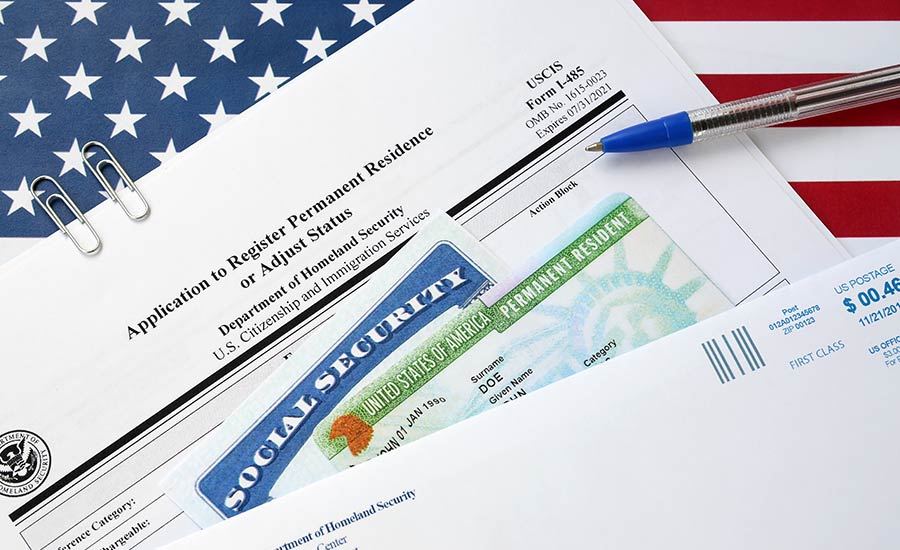

If you are starting your journey to become a lawful permanent resident in the United States, completing Form I-485 is a crucial step in the immigration process.
Here is all you need to know about Form I-485, including its purpose and eligibility, the factors that affect processing time, and how long you might wait for approval.
Our legal team at Spar & Bernstein is here to provide support and guide you throughout the I-485 application process and every step of your journey toward securing your Green Card.
What Is Form I-485?
Form I-485, Application to Register Permanent Residence or Adjust Status, is a document used by eligible individuals in the U.S. to apply for a Green Card without having to return to their home country.
This process is known as adjustment of status.
I-485 is filed with the U.S. Citizenship and Immigration Services and is an important step in the process of obtaining a Green Card, allowing visa holders to live and work permanently in the U.S.
Who Can File I-485?
Form I-485 can be filed by:
- Family-based applicants: Immediate relatives of U.S. citizens (spouses, parents, and unmarried children under 21) and certain relatives in preference categories (unmarried adult children of U.S. citizens, spouses and unmarried children of permanent residents.)
- Employment-based applicants: Individuals with an approved immigrant petition (Form I-140) based on employment — for example, foreign workers with job offers in the U.S. under EB-1, EB-2, and EB-3 visas.
- Refugee or asylee status holders: Refugees and asylees who have been granted protection in the U.S. after meeting certain requirements.
- Human trafficking victims: Individuals who were forced or tricked into labor or sex work and who qualify for protection in the U.S. under a T visa.
- Crime victims: Individuals who suffered harm and helped law enforcement, making them eligible to remain in the U.S. with a U visa.
To file Form I-485, applicants must:
- Be physically present in the United States.
- Have an approved or concurrently filed immigrant petition (if applicable).
- Not be subject to any bars to adjustment of status, such as unlawful presence or other immigration violations, unless an exception or waiver applies.
Eligibility requirements can vary per category, and additional criteria may apply.
That’s why it is essential to review the USCIS guidelines and speak to an experienced immigration attorney — they can help assess your eligibility and the criteria you must meet to get your application approved.

I-485 Processing Time
Once you have established your eligibility to file Form I-485 to adjust your status in the United States, the process involves several key steps.
1. Obtain Form I-485
Download the most current version of Form I-485 from the USCIS website. Using an old form can result in the rejection of your application.
2. Review The Instructions
Read the instructions for Form I-485 provided by USCIS, which explain eligibility, the process, and the supporting documents.
3. Complete Form I-485
Fill out the form and ensure all details are accurate. Review thoroughly for blank fields and mistakes.
4. Gather Supporting Documents
Collect the following required documents, ensure you submit certified English translations if they are issued in a foreign language:
- Copy of government-issued documents — passport or visa
- Birth certificate
- Copy of your Form I-94
- Proof of lawful entry into the U.S. (visa or admission stamp)
- Approved immigrant petition — Form I-130, Form-140, or other
- Medical examination report (Form I-693)
- Marriage certificate (if applicable)
- Form I-864 for family-based applicants
- Employment verification letter for employment-based applicants
- Proof of continuous residence (if required for your category)
- Passport-style photographs
5. Pay Filing Fees
Submit the appropriate filing fee (check the amount in the next section of this article).
6. Submit Your Application
Mail your completed Form I-485, along with the supporting documents and payment confirmation, to the correct USCIS address — it will vary depending on your eligibility category.
7. Receive Receipt Notice
Once you file Form I-485, USCIS typically sends Form I-797C to acknowledge that they received your application. Check out how long it takes to get a receipt notice.
This document contains a receipt number that you can use to track the progress of your application on the USCIS website.
8. Attend Biometrics Appointment
USCIS then schedules a biometrics appointment where you provide your fingerprints, a photograph and your signature.
USCIS uses this data to conduct identity verification and background checks.
9. Attend The Interview
Depending on your immigration category and other factors, USCIS may schedule an interview to further evaluate your eligibility for an adjustment of status.
During the interview, a USCIS officer will ask questions about your application, supporting documents, and eligibility.
The interviewing officer may also review your personal history and ask about your relationship if your application is family-based, or about your employment if your application is employment-based.
3. Receive The Decision
After the interview, USCIS will make a decision on your I-485 application. USCIS may approve your application, request additional evidence or documentation, or deny your application.
If your I-485 application is approved, USCIS will mail your Green Card to the address you listed on your application.
Form I-485: Cost
The fee for Form I-485 is $1,440.
If you are under 14 and are filing Form I-485 with a parent’s Form I-485, you will need to pay $950.
There is no fee for:
- Refugees or individuals who were paroled as refugees
- T visa holders filing under INA section 245(l)
- U visa holders filing under INA section 245(m)
- Self-petitioners filing under Violence Against Women Act (VAWA)
Form I-485: Processing Time
The processing time of Form I-485 may vary depending on the type of application and the field office or service center where you submitted your application.
- For family forms: Between 14 and 23 months.
- For employment applications: Between 8 and 40 months.
- For refugees who were granted admission more than one year before their application submission: 14 months.
- For asylees that were granted asylum more than one year before their application submission: 15 months.
- For T visa holders: 37 months.
- For U visa holders: Between 14 and 28 months.
The time estimates on the USCIS website are calculated based on the time it takes to process 80% of applications over the previous 180 days.
Note that you should accept these quoted processing times as a reference point only — your approval could come sooner, or your application could take longer to process.
To check how long a specific USCIS office typically takes to process Form I-485, visit the Processing Time page on the USCIS website.
To receive an update on your case status:
- Visit the Case Status page and enter your Form I-485 receipt number.
- Submit a case inquiry if you believe that your application is taking longer than usual to process.
- Contact the USCIS Contact Center at 800-375-5283.
- Partner with an experienced immigration law firm, such as Spar & Bernstein, where an attorney can determine the status of your case.
What Can Cause Delays In I-485 Processing?
There are several different factors that can lead to delays in processing Form I-485 applications, including:
- USCIS workload: When USCIS faces high volumes of applications and limited resources over certain periods of time, this can lead to backlogs.
- Request for Evidence (RFE): If USCIS determines that they need additional information to evaluate your application, they may issue an RFE. If you fail to respond to their request for evidence in a timely manner, your application processing can be delayed.
- Incomplete or inaccurate applications: Errors, missing information, or incomplete forms can result in delays, as USCIS may request clarification or additional documentation.
While some factors are beyond your control, you can take measures to ensure that your application is accurately completed and properly filed.
Our team of lawyers at Spar & Bernstein will help you file Form I-485 and make sure you submit all documentation to avoid unnecessary delays.

Need Help With Form I-485? Schedule A Consultation
Dedicated to providing support to immigrants going through the complex process of obtaining a Green Card through Form I-485, our experienced attorneys at Spar & Bernstein are here to help.
We will:
- Evaluate your eligibility
- Prepare all documentation to ensure that your application is set up for approval
- Handle your case with knowledge and compassion
- Prepare you for your interview
- Help throughout the entire Green Card process with immigration forms and legal representation
- Explore legal options if challenges or complications arise
Founded in 1958 to serve in immigration and personal injury law, Spar & Bernstein has a proven track record of successful outcomes in family immigration, asylum and refugee protection, employment immigration, waivers and more.
Schedule a consultation with our team and find out how we can help.
Form I-485: FAQs
Still have questions about Form I-485? Find answers to frequently asked questions below.
Can I work while my I-485 application is pending?
Yes — if you request an employment authorization document, you can work while Form I-485 is pending approval. To do this, file Form I-765. You can file the form concurrently with I-485 or after, while Form I-485 is still pending.
Can I travel internationally while my I-485 application is pending a decision?
If you have a pending I-485 application and you plan to travel, you need to file Form I-131 to obtain an Advance Parole document before leaving the U.S. Without this document, departing the U.S. can be considered as an abandonment of your application.
Can I file Form I-485 concurrently with other applications or petitions?
In some cases, you will be able to file Form I-485 concurrently with other related applications or petitions — like Form I-130 or I-140, for example.
Speak to our knowledgeable immigration attorneys at Spar & Bernstein to determine whether you can file forms concurrently.
Can I expedite the processing of my I-485 application?
Expedited processing may be available in certain cases, such as emergency situations or instances of severe financial loss. To request expedited processing, contact USCIS and provide supporting evidence of an emergency or contact our team at Spar & Bernstein to determine your eligibility for expedited processing.
What’s the difference between adjustment of status and consular processing?
The key difference between adjustment of status and consular processing is the location of the applicant when the Green Card application is filed.
If the applicant is in the U.S., and meets the eligibility, they can file an adjustment of status application. Adjustment of status also allows the applicant to apply for work and travel authorization.
If the applicant is outside the U.S., they need to go through consular processing to apply for a Green Card. When going through consular processing, the applicant is not allowed to request work or travel authorization.


